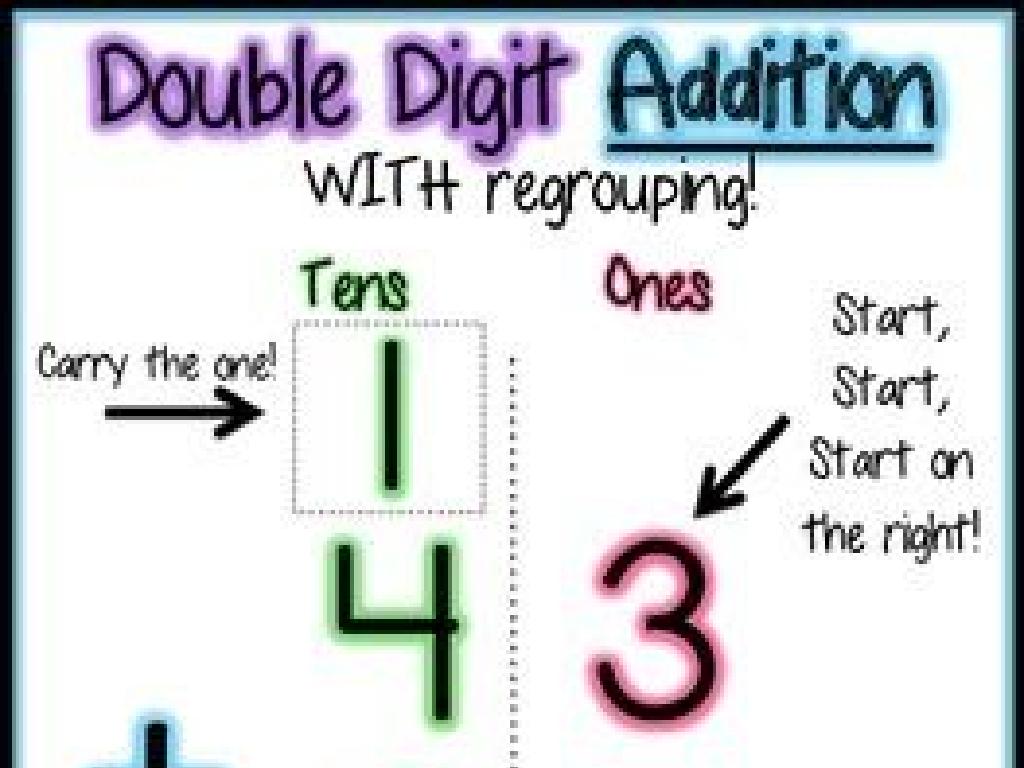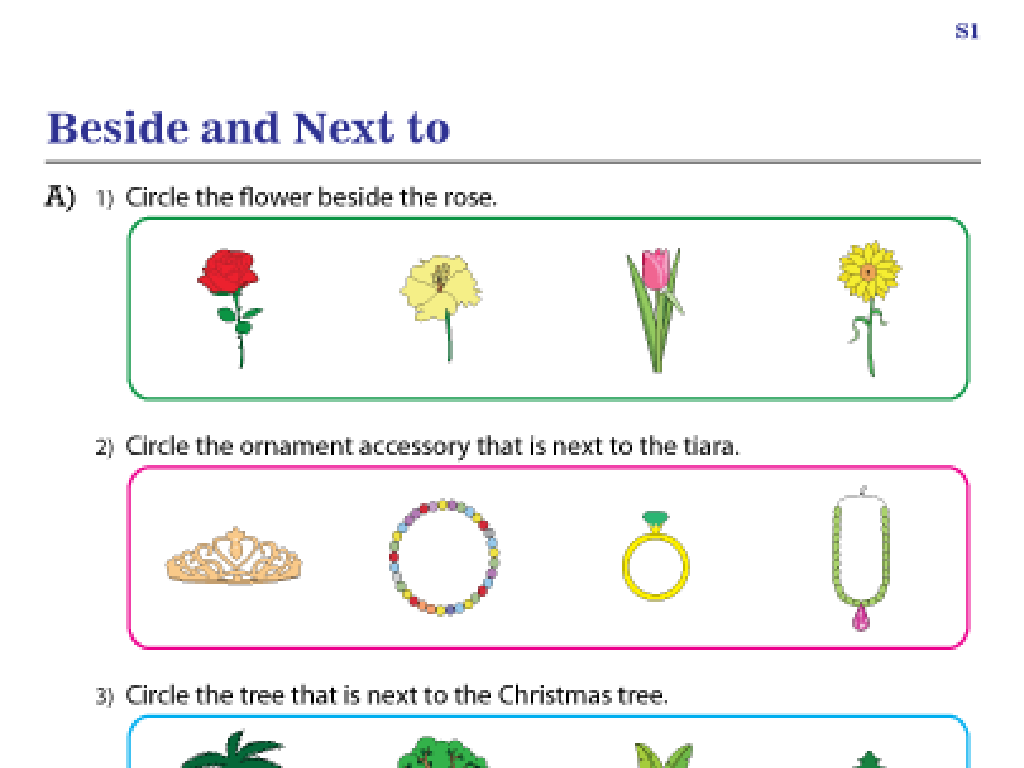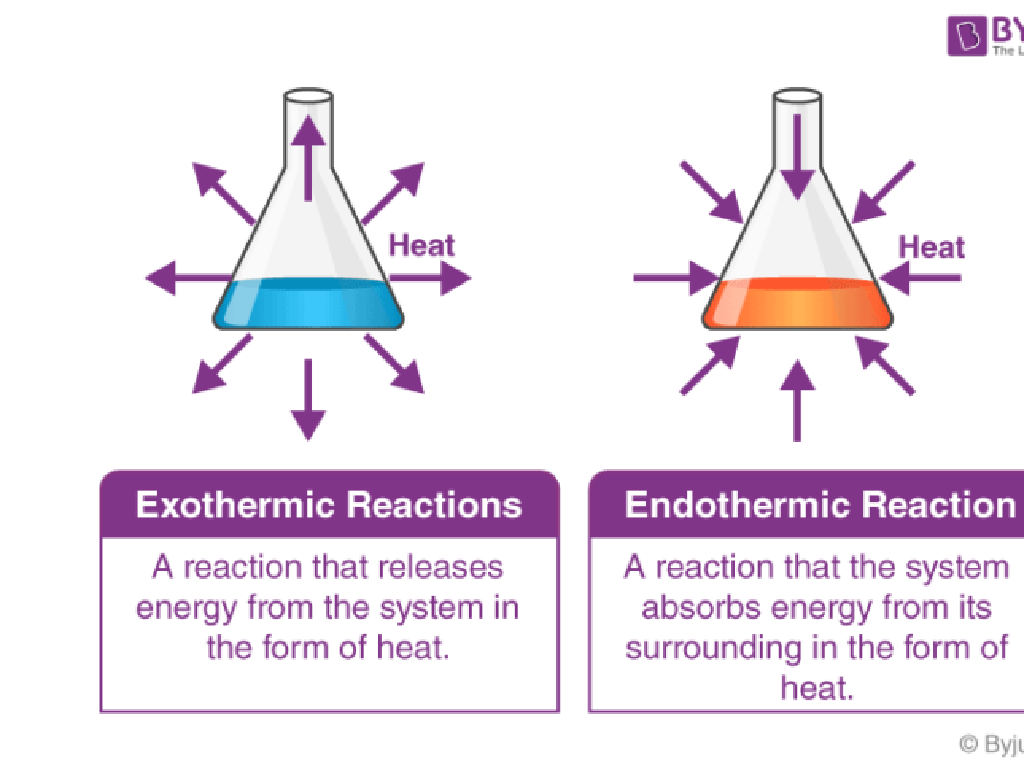Solve Inequalities Using Addition And Subtraction Shortcuts
Subject: Math
Grade: Second grade
Topic: Mixed Operations: Three Digits
Please LOG IN to download the presentation. Access is available to registered users only.
View More Content
Solving Inequalities with Addition and Subtraction
– What are inequalities?
– Inequalities show if one number is smaller or larger than another.
– Using addition to solve
– Add the same number to both sides to keep the inequality true.
– Using subtraction to solve
– Subtract the same number from both sides to maintain the inequality.
– Practice with examples
|
Begin the lesson by explaining the concept of inequalities, emphasizing that they are like a balance scale where both sides need to stay balanced. Introduce addition and subtraction as tools to solve inequalities, ensuring to maintain the balance by doing the same operation on both sides. Provide clear examples, such as if we have 5 < 8 and we add 2 to both sides, it becomes 7 7, and if we subtract 2 from both sides, it becomes 8 > 5. Conclude with practice problems where students apply these shortcuts to solve inequalities, reinforcing their understanding through repetition.
Understanding Inequalities
– Inequalities are like seesaws
– They show which number is bigger or smaller
– Symbols: >, means greater, 3 means 5 is bigger than 3
– Practice with real examples
– Let’s try 7 < 10 and 4 = 4 together in class
|
This slide introduces the concept of inequalities to second-grade students by comparing them to something familiar a seesaw. This visual helps them understand that inequalities show which numbers are bigger or smaller. Introduce the symbols for greater than, less than, and equal to, and ensure students can identify and use them correctly. Provide clear examples using single-digit numbers to illustrate the concept. During class, engage students with hands-on practice, using real-life examples such as comparing the number of apples in two different baskets or the heights of two plants. This will help solidify their understanding of inequalities and the symbols used to represent them.
Solving Inequalities: Addition Shortcut
– Adding moves RIGHT on number line
– Imagine hopping to the right each time we add
– Numbers get BIGGER with addition
– Think of adding as ‘growing’ the number
|
This slide introduces the concept of using a number line to visualize addition as a movement to the right, which makes the value of numbers larger. Emphasize to students that every step to the right on the number line increases the number by one unit. Use examples like adding small amounts to a piggy bank to illustrate how the total amount ‘grows’ or gets bigger with each addition. Encourage students to practice with physical number lines or drawings to reinforce the concept. This foundational understanding will help them grasp how to solve inequalities by recognizing that addition increases the value of a number.
Subtraction Shortcut: Moving Left on the Number Line
– Subtraction means moving left
– Numbers get smaller with subtraction
– Example: 15 – 4 moves left to 11
– Starting at 15, count back 4 steps to land on 11
– Practice with number line activities
– Draw a number line, mark numbers, and show subtraction by jumping back
|
This slide introduces the concept of subtraction as a movement to the left on the number line, which helps students visualize the process. Emphasize that when we subtract, the numbers become smaller. Use a number line drawn on the board or on paper to demonstrate with an example, such as 15 – 4. Have students practice by drawing their own number lines and performing subtraction operations. Encourage them to count the steps back to ensure they understand the concept of ‘moving left’ equals subtracting. This visual approach aids in solidifying their understanding of subtraction as reducing the value of numbers.
Let’s Practice Inequalities with Addition!
– Start with 5 < 8
– Add 2 to both sides
– We get 5 + 2 < 8 + 2
– What's the new inequality?
– Now we have 7 < 10
– Does the inequality sign change?
– No, it stays the same!
|
This slide is an interactive class activity to help students understand how inequalities are affected by the addition of the same number to both sides. Begin by presenting the initial inequality, 5 < 8. Then, guide the students to add 2 to both sides of the inequality. Ask the class what the new inequality is and confirm that it is 7 < 10. Reinforce the concept that the inequality sign does not change when the same amount is added to both sides. Encourage students to explain the process in their own words and provide additional examples if needed. This activity will build their confidence in solving inequalities using addition.
Your Turn to Solve Inequalities!
– Try solving problems independently
– Use addition shortcuts
– If ‘x + 3 7’, find x. Hint: Think opposite of subtraction
– Check your answers
|
This slide is an activity for students to practice solving inequalities using the addition and subtraction shortcuts they’ve learned. Encourage them to work through the problems independently, reinforcing the concept that ‘undoing’ the operation can help find the value of the variable. For addition, they should subtract the same number from both sides of the inequality, and for subtraction, they should add. After solving, students should check their answers by plugging the value of the variable back into the original inequality to ensure it makes a true statement. Provide guidance and be ready to assist if they encounter difficulties. Possible activities include solving different inequalities on the board, peer-review sessions, or creating their own inequalities for classmates to solve.
Class Activity: Inequality Hopscotch
– Understand inequalities through play
– Each square has a different number
– Use addition/subtraction to hop correctly
– If the square is 5 and we add 3, where do we hop?
– Hop to squares showing greater/lesser numbers
– Decide to hop forward or backward based on the inequality
|
This interactive activity is designed to help second graders understand the concept of inequalities by using a familiar playground game, hopscotch. Set up a hopscotch grid with numbers in each square. Students will use addition and subtraction shortcuts to determine which square to hop to next, based on whether they need to find a greater or lesser number. For example, if a student is on square 5 and needs to add 3, they should hop to square 8. Conversely, if they need to subtract 2 from 5, they should hop to square 3. This physical activity will help them visualize and solve inequalities in a fun and engaging way. Prepare different scenarios for each student to ensure a comprehensive understanding of the concept.
Great Work on Inequalities!
– Congratulations on learning inequalities!
– Practice is key to mastering skills
– Keep practicing addition and subtraction
– Try using number lines for help
– Use shortcuts to solve inequalities
– Remember, shortcuts like ‘adding the same number’ help find answers faster
|
This slide wraps up the lesson on solving inequalities using addition and subtraction shortcuts. It’s important to congratulate the students on their hard work and remind them that continued practice is essential for mastery. Encourage them to keep practicing the techniques they’ve learned, using tools like number lines to visualize the problems. Emphasize the usefulness of shortcuts, such as adding or subtracting the same number from both sides of the inequality, to find solutions more efficiently. Reinforce the idea that learning math is a step-by-step process, and with each practice, they are becoming better at solving inequalities.






